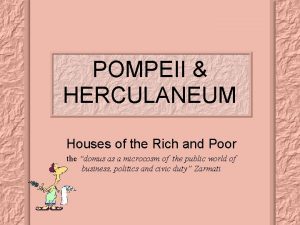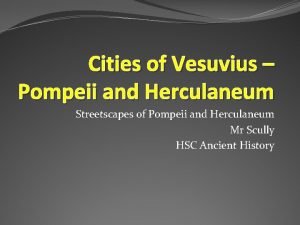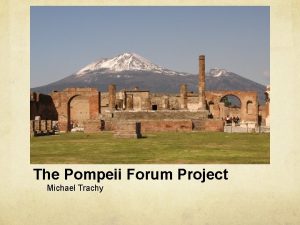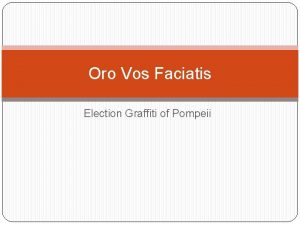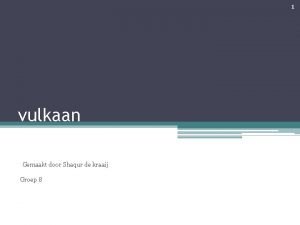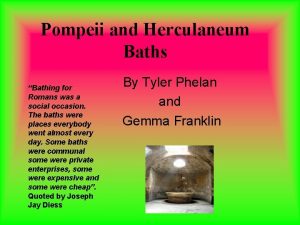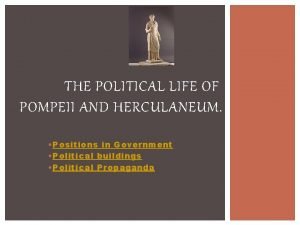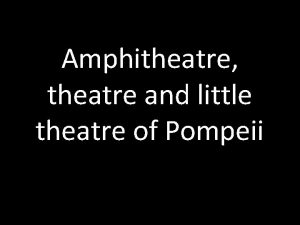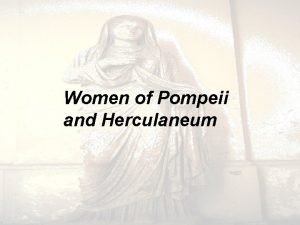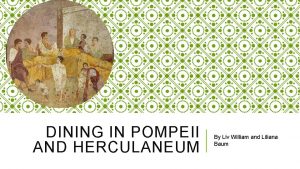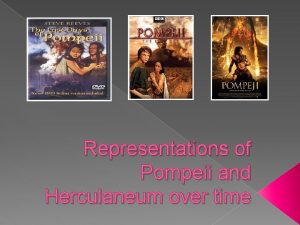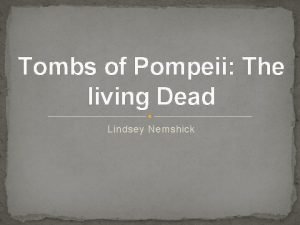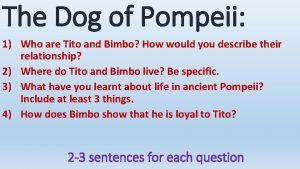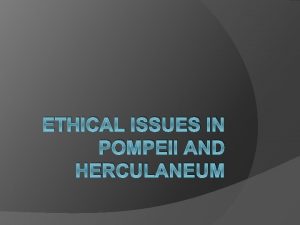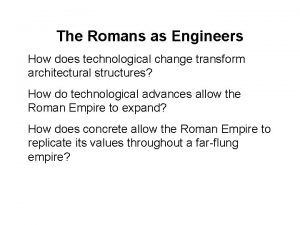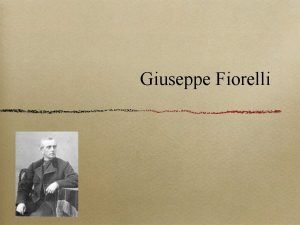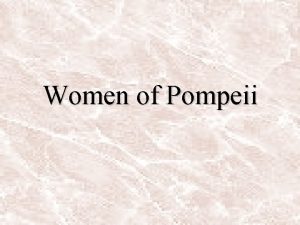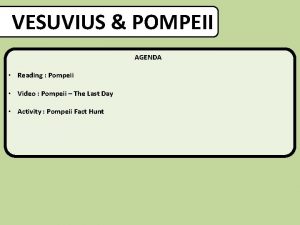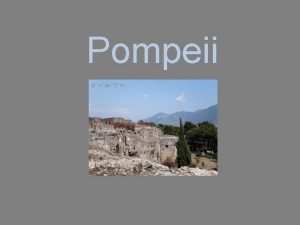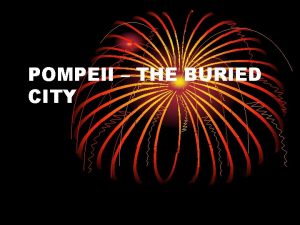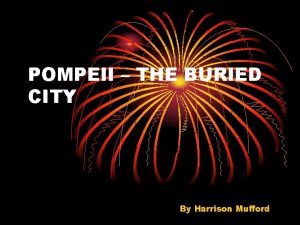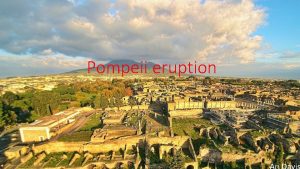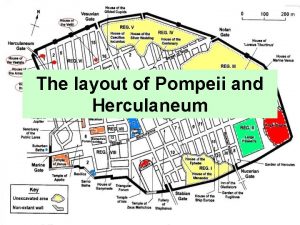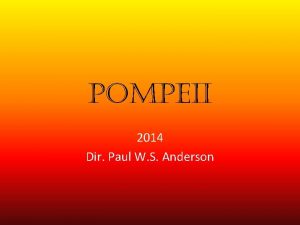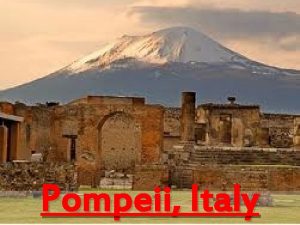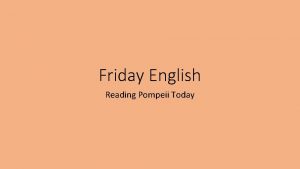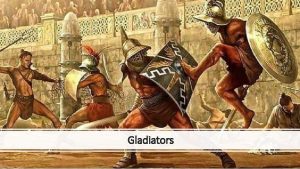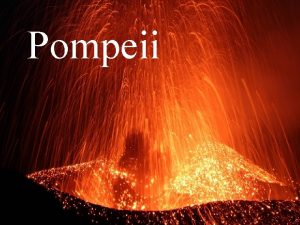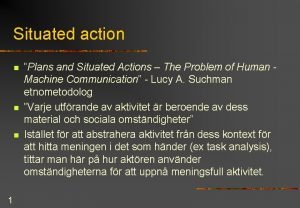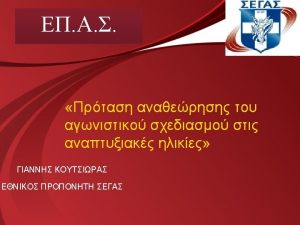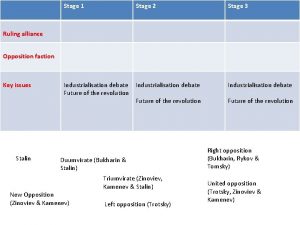STAGE 1 POMPEII Pompeii was situated at the



































- Slides: 35

STAGE 1

POMPEII Pompeii was situated at the foot of mountain Vesuvius on the Bay of Naples, and may have had a population of about 10, 000. Pompeii was located southeast of Rome.

Caecilius& his family • • • Lucius Caecilius Iucundus and his family lived in Italy during the 1 st century AD in Pompeii. He was a rich Pompeian banker & businessman. When archeologists excavated his house, they discovered his accounts in a strongbox; these documents tell about his business dealings. 153 documents in the form of tax tablets were found in his house. They included receipts, contracts and loan documents. He inherited some of his money, but made most of it through business activities. He dealt in slaves, cloth, timber, & property, ran a dyeing business, raised sheep & cattle, & had a contract for collecting local taxes.

Caecilius

ROMAN NAMES • A male Roman citizen usually had 3 names. • Praenomen-”Lucius”-personal name • Nomen-”Caecilius”-name of the “clan” or the group of families to which he belonged • Cognomen-”Iucundus” name of his own family and close relatives. It is often descriptive. Iucundus means pleasant.

• Slaves usually had only one name. If their owner freed them (which was common), they became freedmen, and they usually took the praenomen and nomen of their master, using their old name as their cognomen. For example, if Caecilius freed his slave Grumio, Grumio would probablly be Lucius Caecilius Grumio. • Girls and women usually had a feminine form of their father’s Nomen. For example, all the daughters of Caecilius would have been named Caecilia. If there were more than one, they would have been Caecilia Prima, Caecilia Secunda, etc.

Metella • Roman women were not equal, could not vote and were expected to obey their fathers and husbands • However, they had much greater personal freedom and freedom of behavior than women in other parts of the Mediterranean world, and were held in high respect • Ran the household, supervised children & slaves, had her husband’s confidence • Although their lives did center on the home, they did not live in seclusion; they went out to shop, visit friends, attended public events, attended parties; dined next to their husbands at banquets • Roman marriage was monogamous (only one wife). However divorce was allowed and not uncommon • Upper class women were well educated and informed, and took part in social and literary conversation • Working class women occasionally ran businesses, usually when a widow took control of their deceased husband’s affairs.


villa-country estate; domus-town house; insula-apartment building; casa: cottage • Domus • Came right up to the sidewalk with no grass in front • Outside windows were few, small, fairly high • Some were one story, some two stories • On either side of the front door, many houses had shops, which were rented out by the owner of the house.


Feature of the Atrium • Ianua-door • Fauces: entrance hall • Atrium-main formal room; was very open with little furniture (maybe a marble table, strongbox and couch). The floor was paved with marble slabs or mosaics & the walls were decorated with panels of brightly painted plaster. • Compluvium: square opening in the roof of the atrium, through which came light, air, rain. • Impluvium: marble-lined, shallow rectangular pool that collected rainwater, which was then stored in a cistern for household use. • Lararium: small shrine in the corner near the door, at which the family gods were worshiped.

Atrium

Atrium-Water and light flowed through a hole in the ceiling called the compluvium, into a pool called the impluvium


Lararium-shrine in the atrium, where the household gods, the Lares and Penates, were worshiped.

• Around the atrium were arranged the tablinum, triclinium and cubicula • Tablinum: study • Triclinium: dining room • Cubiculum: bedroom • Behind the tablinum were the Peristylium, hortus and latrina • Peristylium: colonnade of pillars surrounding a hortus (garden) • Hortus: garden, laid out with flowers, shrubs, a fishpond, and sometimes a fountain. It served as a family room and general place to hang out. • Latrina: toilet or bathroom • Culina: kitchen

Tablinum: usually right behind the atrium

triclinium



Cubiculum


Peristylium


culina

Cave canem



Poor people in the city lived in apartment buildings called insulae, several stories high



Daily life-Clothing • Romans usually got up at about dawn, which was the 1 st hour of the day. They dressed: • Women’s clothing • Tunica-shirt like garment • Stola-dress worn on top of the tunica • Palla-piece of cloth worn like a shawl. Roman man’s basic clothing: • Tunica • Toga-formal outer garment

Patronus-clientes • Often in the morning, a wealthy man would be visited by his clients. Then he might go take care of business in the forum. • Patronus-a wealthier man who gave help and protection to underlings, called clientes • Clientes (cliens-singular; clientes- plural)- “clients” a less wealthy men who gave loyalty and support to a patron • Salutatio-event in the morning when clients came to greet their patron. • Forum: town/city center, with public buildings.

MEALS • Ientaculum: breakfast-simple meal, mostly bread • Prandium: lunch, simple meal • Cena-dinnerelaborate meal

Cena in the Triclinium • In a Roman triclinium, there were three large couches arranged around a central table. Up to three people (total of 9) reclined on each. Both women and men ate reclining in the triclinium. Small children generally ate at a table sitting up. • Mensa: table • Lectus: couch • Panis: bread; vinum: wine • Ab ovo usque ad mala: from eggs to apples.
 Scotland is situated
Scotland is situated What is discourse analysis
What is discourse analysis Situated and invented ethos
Situated and invented ethos Situated language learning
Situated language learning Difference between single and two-stage tendering
Difference between single and two-stage tendering Stage 1: denial
Stage 1: denial Downstage and upstage
Downstage and upstage Acting area definition
Acting area definition Downstage and upstage
Downstage and upstage Proscenium stage
Proscenium stage Pompeii house plan
Pompeii house plan Pompeii
Pompeii Pompeii gates
Pompeii gates Pompeii forum reconstruction
Pompeii forum reconstruction Marcus vesonius primus
Marcus vesonius primus Wat is de kleinste vulkaan ter wereld
Wat is de kleinste vulkaan ter wereld Basilica town
Basilica town Herculaneum baths
Herculaneum baths Pompeii and herculaneum source booklet
Pompeii and herculaneum source booklet Comitium pompeii
Comitium pompeii Amphitheatre and theatre
Amphitheatre and theatre Herculaneum women
Herculaneum women Food and dining in pompeii and herculaneum
Food and dining in pompeii and herculaneum Pompeii the last day bbc
Pompeii the last day bbc A day in pompeii vimeo
A day in pompeii vimeo Pompeii's living dead
Pompeii's living dead Why did bimbo bite tito?
Why did bimbo bite tito? Muleteer pompeii
Muleteer pompeii Roman concrete
Roman concrete Story elements flipbook
Story elements flipbook Giuseppe fiorelli
Giuseppe fiorelli Chụp tư thế worms-breton
Chụp tư thế worms-breton ưu thế lai là gì
ưu thế lai là gì Thẻ vin
Thẻ vin Tư thế ngồi viết
Tư thế ngồi viết Cái miệng xinh xinh thế chỉ nói điều hay thôi
Cái miệng xinh xinh thế chỉ nói điều hay thôi










